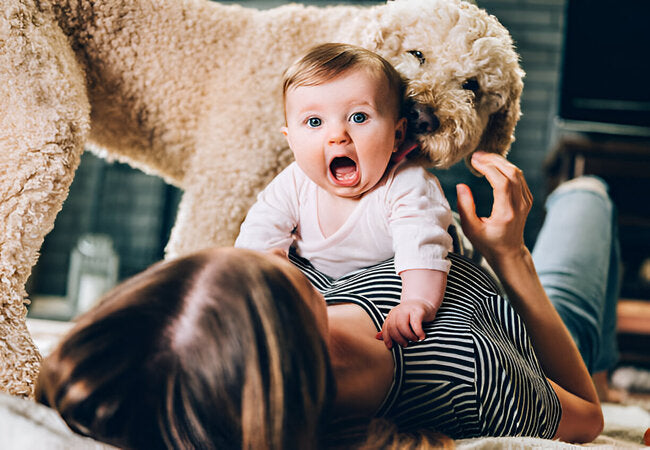Why Dogs Lick Everything in 2025 – Vet‑Approved Guide to Behavior, Health & Training 🐶👅

In this article
Why Dogs Lick Everything in 2025 – Vet‑Approved Guide to Behavior, Health & Training 🐶👅
By Dr. Duncan Houston BVSc
Does your dog seem to lick *everything*—hands, floors, furniture, or even air? 😋 This behavior is common yet often misunderstood. In this vet‑approved 2025 guide, we'll explore the medical, emotional, and behavioral reasons dogs lick, identify when it could be a red flag, and outline compassionate strategies to manage or redirect licking positively.
1. Natural Exploration & Communication
Dogs primarily explore their environment with their mouths and tongues, much as infants use their hands. They lick to taste, gather sensory info, and even communicate affection or submission.
- Curiosity: Licking surfaces or objects is a way to investigate what they are.
- Social behavior: Dogs groom their loved ones, share bonding through licking—similar to maternal grooming in puppies.
- Calming signals: Lip or nose licking may communicate peace or reduce tension in both dog-dog–and dog–human interactions.
2. Affection & Attention Seeking
Licking frequently shows affection—akin to kisses—but can also become a learned way to get attention.
- If you react by petting or playing when your dog licks you, you reinforce that behavior—even negative reactions count!
- Some dogs learn quickly that licking brings interaction, treats, or even you stopping unwanted behavior by pushing them away.
3. Boredom, Anxiety & Self‑Soothing
Excessive licking may indicate stress or anxiety. Dogs release calming endorphins through licking, similar to nail‑biting or hair‑twirling in humans.
- Licking furniture, carpets, or your legs may be a displacement activity when they feel uneasy, alone, or bored.
- Stressors like fireworks, changes in routine, or separation can trigger obsessive licking.
4. Medical & Health‑Related Causes
Licking isn’t always behavioral—it can signal health issues, too:
- Allergies, skin issues, infections: Dogs often lick itchy spots, particularly paws or flanks.
- Digestive issues or nausea: Licking floors can be a way to soothe stomach discomfort.
- Pica or nutritional deficiency: Persistent licking of non‑food items may indicate pica—veterinary assessment is essential.
- Cognitive decline: Senior dogs may lick repetitively due to cognitive dysfunction or neurological issues.
5. When to Be Concerned
Not all licking requires a vet, but consult one if:
- Licking becomes excessive or obsessive, especially to the point of injury, hair loss, or open sores (like lick granuloma).
- It appears suddenly or along with other symptoms like vomiting, diarrhea, lethargy, or limping.
- Licking persists post‑medical treatment or seems compulsive—an anxiety or behavioral specialist may need to assess it.
6. Vet & Behaviorist Evaluation
- Physical exam: Look for skin allergies, parasites, GI issues, or pain points.
- Diagnostic tests: Bloodwork, stool analysis, allergy panels, or cognitive assessments may be recommended.
- Behavior assessment: Determine if licking is a coping mechanism or habitual. A behaviorist can help design a plan.
7. Gentle Management Strategies
A. Increase Mental & Physical Stimulation
- Daily walks, playtime, and interactive toys/puzzle feeders help reduce boredom-driven licking.
- Rotate toys and introduce scent games to keep your dog engaged.
B. Redirect & Reinforce Alternative Behavior
- When you spot licking, calmly redirect to a chew or lick-safe toy and reward with praise or small treats.
- Teach a “Leave it” or “Place” cue to interrupt repeated licking and reward compliance.
C. Environmental & Calm Enhancements
- Provide calming spaces (e.g., crate with soft bedding, pheromone diffusers, quiet zones) for anxious dogs.
- Block off or clean commonly licked surfaces to reduce unhealthy licking behavior.
D. Medical Treatment for Skin/Wounds
- Treat allergies, infections, or wounds with vet-prescribed medications to reduce itchiness and licking.
- Use Elizabethan collars when necessary during healing phases of lick granulomas.
E. Address Pica & Nutritional Needs
- Adjust diet under your veterinarian’s guidance to correct deficiencies.
- Offer lick mats with dog-safe spreads to satisfy licking instincts in controlled ways.
F. Behavioral Therapy & Medication
- Develop a behavior modification plan to desensitize triggers and replace licking behaviors.
- For severe compulsive licking, anti‑anxiety medications may be prescribed alongside therapy.
8. Real‑Life Example
> “She stopped licking the couch once I started giving her a frozen Kong every afternoon—she looks forward to it now instead!”
9. Quick‑Reference Table
Affection/attentionAnxiety/boredom, Medical issue, Compulsive/pica
| Cause | Signs | Approach |
|---|---|---|
| Exploration | Licks various surfaces briefly | Observe; provide safe lick toys |
| Licks people often | Ignore unwanted, reinforce calm | |
| Repetitive licking of surfaces | Enrichment, calm space, behavior plan | |
| Licks specific body areas/excessively | Vet exam & treat underlying cause | |
| Licks non‑food items persistently | Medical & behaviorist plan |
10. 📱 Ask A Vet App 2025 Support
Use the Ask A Vet app to:
- 📹 Upload a video of licking behavior for veterinary advice.
- 🧩 Get tailored behavior plans—enrichment, redirection, or separation anxiety therapy.
- 💬 Access live support to track progress or recommend vet follow-up.
Personalized guidance helps tackle licking at its root, supporting your dog’s best quality of life. 🐾📲
❤️ Final Thoughts
Licking is a natural part of dog behavior—used for exploration, bonding, comforting, and grooming. But when it becomes excessive or focused on certain areas, it's time to investigate. In 2025, we blend compassionate observation, behavioral strategy, and veterinary insight to help dogs lick well—without compromising health or harmony. 🐶👅
Need expert help? Visit AskAVet.com or download the Ask A Vet app for personalized behavior support and peace of mind.






